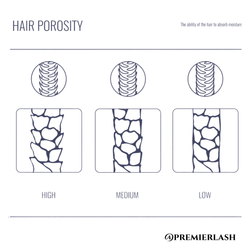Pro Tip: Understanding The 3 Types of Lash Porosity
Aug 30th 2025
Understanding Lash Porosity will help you achieve the desired results of longer lasting extensions.
More and more stylists are retiring lash primer in favor of saline and bonder—and with good reason. By understanding how lash porosity works, you can prep the natural lash for optimal adhesion and achieve noticeably longer retention.
What is Lash Porosity?
Porosity refers to how well the natural lash can absorb and retain moisture—or, in this case, adhesive. The outer layer of each lash, called the cuticle, is made up of overlapping, flexible cells. These cuticles can open and close, influencing how extensions bond. Lashes generally fall into one of three porosity categories:
Low Porosity:
- Cuticles are tightly packed, giving lashes a glossy, smooth, sometimes oily appearance.
- The smooth surface makes it difficult for adhesive to grip.
- Instead of relying on primer, gently cleanse with saline to remove excess oils and lightly use a bonder to encourage cuticle flexibility for better adhesion.
Medium Porosity:
- Cuticles are slightly lifted, giving lashes a subtle texture.
- This is the most common porosity type stylists encounter.
- Prepping with saline ensures a clean surface, while bonder helps lock in a stronger adhesive bond.
High Porosity:
- Cuticles are wide open, making lashes absorbent and naturally receptive to adhesive.
- Identified by their matte or dull appearance.
- These lashes are a stylist’s dream—quick bonding and excellent retention. Simply cleanse with saline or lash shampoo to remove impurities, then proceed with application.
Why It Matters
Retention isn’t just about the adhesive—it’s about how the natural lash receives it. By using saline and bonder to manage porosity, you’re not forcing the lash to behave (as primer often does); instead, you’re working with the lash’s natural structure. This results in healthier lashes, stronger bonds, and longer-lasting extensions.
